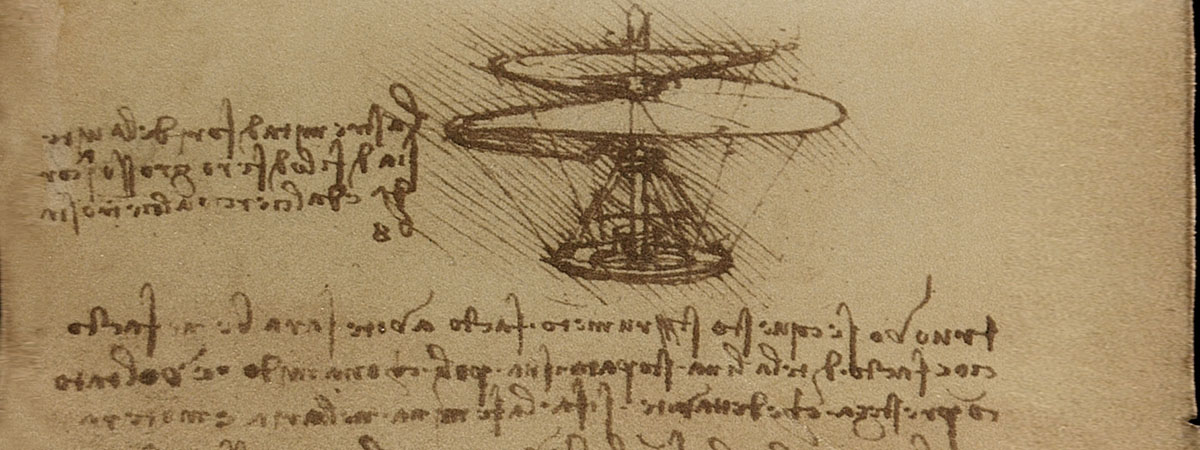Last May marked the 500th anniversary of the death of a person who may have been more ahead of their time than anybody else has been in the history of humankind: Leonardo da Vinci.
Leonardo was a Florentine polymath of the Italian Renaissance, and is renowned for his many works in a variety of different fields. However, like many geniuses, he did not get the recognition he deserved until the end of his life. Leonardo failed constantly again and again, but he failed better every time, turning each failure into a step towards success. This is how all geniuses that make the history books are forged.
Some of the aeronautical concepts developed by da Vinci are still in practice today, more than five hundred years later.
He dreamed of flying from a young age, as a few people had done before him and many others have done since. Leonardo was one of the first people to devise several machines designed to lift us off the ground. To do this, he carried out detailed studies on the flight of birds, including wing mechanics and anatomy, distribution of feathers, etc.
Among his many notes, he made the following aeronautical designs:
- “Helicopter”: He devised a machine with a helical screw design that he calculated could be lifted using a rotor driven by four men, in order to achieve sufficient speed and overcome inertia. It was basically a transposition of the Archimedes’ Screw idea, but using air as the fluid instead of water.
The design’s error was that the helical screw resulted in penetration resistance, rather than lift. Subsequently, he corrected this problem by making small-scale models. However, it was still one of the first conceptualisations of a “heavier-than-air” machine being able to fly.
- Wings: Da Vinci made a compendium of wing designs. The idea was simple: to give a person articulated wings, just like a bird. His wings were based on anatomical studies of bird and bat wings, but on a larger scale. This prevented the person from being able to flap the wings at the speed necessary to generate lift. Thus, he ended up opting for a fixed wing concept, which led to his glider.
- Glider: He observed the flight of large birds and came to the conclusion that, in the absence of a mechanism driven by human force, the most technologically viable option for flight was gliding “without flapping wings”.
He conceived gadgets with a light structure similar to that of an unfolded wing, with light ribs that were much the same as bat fingers, emulating the structure of bones and cartilage found in the wings of large birds. He called this device a “giant bird” and dreamed of testing it from Monte Ceceri, near Florence. This idea is the basis of today’s hang gliders.
- Parachute: After analysing the importance of air resistance, currents and the atmosphere, Leonardo outlined the precursor of a parachute, made out of bags of air. These bags would form a kind of square pyramid, with a base and height of just over 7 metres. He speculated that a person could throw themselves off a certain height with the parachute and not get hurt. Modern recreations of this first parachute have proved Leonardo was right.
- Ornithopter: Leonardo designed a mechanism that had to be propelled by a crewmember who was placed inside a frame and who used their arms to operate two lateral wing-like extensions, like using oars in a boat.
However, he realised that human musculature was not powerful or versatile enough to lift this machine.
Leonardo firmly believed that the key to success laid in the air currents that would help lift his machines into flight, just as birds glide from one current to another without having to flap their wings. It turns out he was right, at least in terms of the science underlying his glider.
He also made notes concerning the materials that could be used for each design. He speculated about how unwise it would be to use metal in these machines, which would add weight to the structures and increase the fragility of joints, due to oxidation and low flexibility of movement. Instead, he recommended the use of wood, tanned leather, silk ropes, etc.
Today, some of his designs have been tested, with mixed results. All his designs demonstrated the highest levels of detailed study that Leonardo used to develop everything related to the possibility of flying; clearly, he was way ahead of his time. His attitude can be found engraved as a motto on his seal: “Impedimento non mi piega” (No obstacle will stop me). Many of these designs served as primitive ideas for modern aerodynes, which nowadays seem as common as the air that holds them up.



